#Sorbonne université
Explore tagged Tumblr posts
Text
Napoleon reopens the Sorbonne after it was closed down in 1793

Place de la Sorbonne — Victor-Jean Nicolle (1754-1826), early 19th century
“Abolished in 1793, the faculties were recreated under the Empire in 1806, the official date of birth of the faculties of letters and sciences.”
French:
Supprimées en 1793, les facultés sont recréées sous l’Empire en 1806, date de naissance officielle des facultés de lettres et de sciences.
Source: Sorbonne université — Histoire
#universities#university#Sorbonne#napoleon#napoleonic era#napoleonic#napoleon bonaparte#first french empire#french empire#history#Victor-Jean Nicolle#Nicolle#france#Paris#1800s#college#the Sorbonne#Place de la Sorbonne#art#19th century#french revolution#Sorbonne université#academia#napoleonic reforms#Napoleon’s reforms#reforms
25 notes
·
View notes
Text
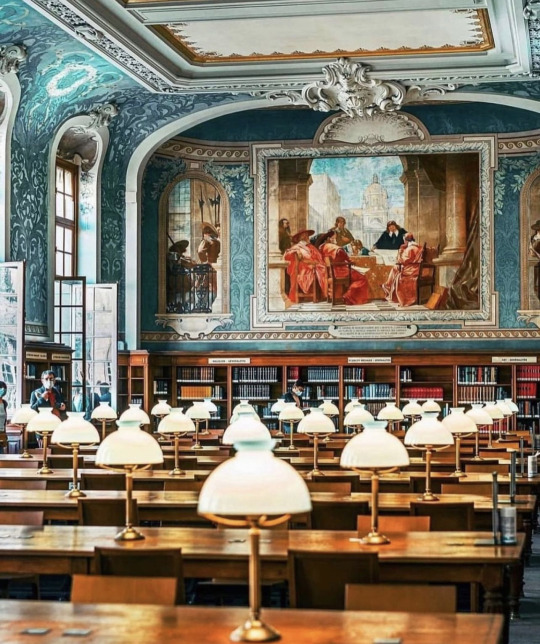
6 notes
·
View notes
Photo
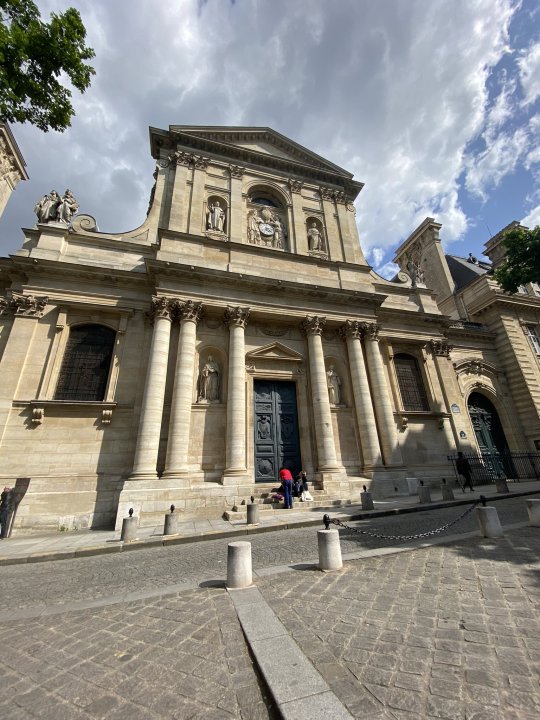
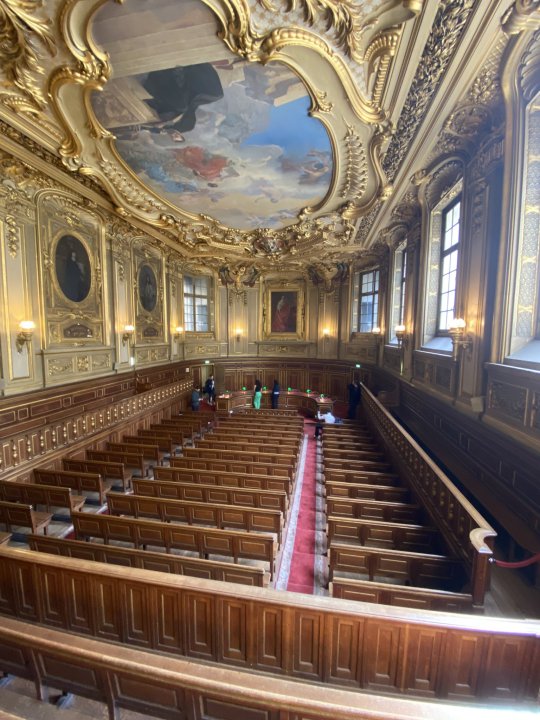
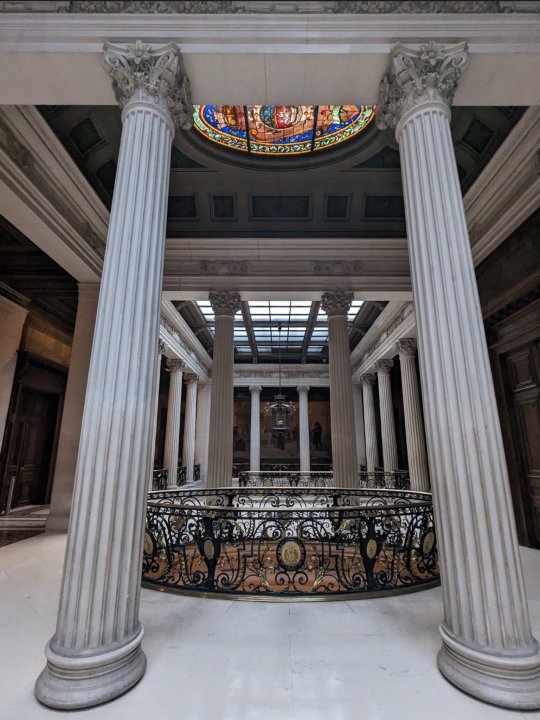
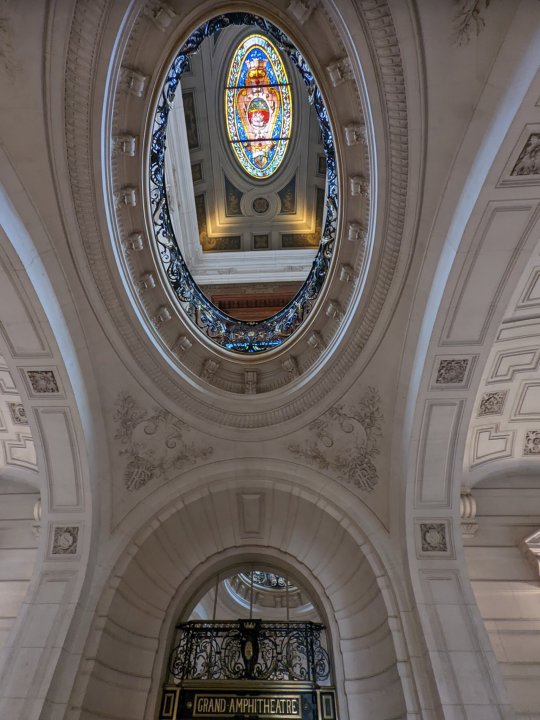
Without defending the citadel of the mind, how can we build a beautiful city? Without the conviction of true propositions, whence do we think beauty will come?
- Sir Roger Scruton
La Sorbonne was named for its founder, Robert de Sorbon, chaplain and confessor of Louis IX. The history of the institution has always been closely linked with that of the University of Paris, one of the most important medieval universities of the French capital. Throughout the centuries, la Sorbonne became and remained a prestigious symbol of the university, training and teaching many of the great philosophers and masters of theology and history.
The University of Paris opened its doors in the 13th century. It was formed from a conglomeration of all of the colleges of the city's left bank. It was here that training occurred for all of Paris' clergy, administrators of royal institutions (courts of audit, courts, parliament, the council of state), as well as agents of ecclesiastical institutions ((bishops, abbots, education and hospital agents). Young students of the Four Nations at the time (French, Normandy, Picardy and English) came there to study law, medicine, theology and the arts. Thus, the University enjoyed unmatched prestige and international renown. In 1253, Robert de Sorbon opened his school on the Parisian Mountain, Sainte-Geneviève. The institution was primarily meant to train the poorest students (like many other colleges on the hill), but soon the Collège de Sorbon acquired a reputation, gradually becoming the famous theological faculty La Sorbonne .
The 17th century brought change. In an effort to bring new life to the old buildings, Cardinal Duc de Richelieu appointed architect Jacques Lemercier to undertake updates to the Sorbonne's structures. Cardinal Richelieu was very involved in the life of the Sorbonne and would go on to become headmaster in 1622.
The turmoil of the French Revolution would force the doors of the Sorbonne to close for a time. Starting in 1801 the Sorbonne housed simple artist workshops. During the Restoration, Louis XVIII decided to restore the buildings of the Sorbonne to their original purpose: education. In 1821, the Paris Academy and the École des Chartes (which trained students in archival conservation and preserving written heritage) took possession of the Sorbonne.
#scruton#roger scruton#quote#la sorbonne#université#university#paris#beauty#architecture#design#citadel#learning#education#france
74 notes
·
View notes
Text

Medal, Université de Paris (1895)
#the sorbonne#paris 2024#paris olympics#olympics#medal#fluctuat nec mergitur#paris#city of paris#sorbonne#ship#waves#latin#université de paris#1800s#1890s#19th century#fin de siècle
2 notes
·
View notes
Text

Sorbonne Université, Paris
#academia#academism#light academia#cozy academia#books and reading#architecture#paris#sorbonne#france#university#classical#classic academia#darkacademia
19 notes
·
View notes
Text

Thermoelectric effect between two liquid materials observed for the first time
A trio of physicists at Sorbonne Université, in France, has observed a thermoelectric effect between two liquid materials for the first time. In their study, published in Proceedings of the National Academy of Sciences, Marlone Vernet, Stephan Fauve and Christophe Gissinger put two types of liquid metals together at room temperature and subjected them to a heat gradient. Scientists have known for many years that thermoelectric devices can convert thermal energy into electricity and vice versa. Such thermoelectric effects have been seen in the interfaces between two solids and between solids and liquids—but until now, never between two liquids. In this new effort, the researchers built an environment conducive to such an event and tested it in their lab. The environment consisted of a cylinder with another smaller cylinder at its center. The researchers poured liquid mercury into the outer cylinder and then poured liquid gallium on top of it. The gallium floated because it was lighter. They then added a chilling device to cool the outer walls of the outer cylinder and a heating device to warm the walls of the inner cylinder.
Read more.
43 notes
·
View notes
Text
Cilia Back
Scoliosis is a human condition where the spine develops a curve yet its cause is still a little mysterious. Here, researchers turn to a simpler but similar organism, the zebrafish, for clues. Assembled in 3D from micro-computed tomography images, we see the healthy spine of a young zebrafish (grey) and curved spines of three different fish (highlighted in bright colours) laid over the top. These fish have a genetic mutation – but how might this lead to scoliosis? The key could be cilia – hairlike structures on the surface of cells. Their mutation changes the cilia so they can’t transfer important chemicals, or waft cerebrospinal fluid around as efficiently as they do in healthy fish. Researchers believe this leads to a build up of astroglia cells, preventing the spine from shaping properly. As the developing human nervous system also relies on cilia, these important clues might influence future therapies.
Written by John Ankers
Video from work by Morgane Djebar and colleagues
Sorbonne Université, CNRS UMR7622, INSERM U1156, Institut de Biologie Paris Seine (IBPS) - Developmental Biology Unit, Paris, France
Video originally published with a Creative Commons Attribution 4.0 International (CC BY 4.0)
Published in eLife, October 2024
You can also follow BPoD on Instagram, Twitter and Facebook
12 notes
·
View notes
Text
La Vérité
AU: Anatomy of a Fall (2023)
Vincent Renzi x Original Female Character fanfic.
Summary: Two people connected by the same past. Two lawyers. And one tangled case which brought them back together again, giving them the opportunity to sort out their feelings towards each other, no matter how painful memories are to both of them can be.

Chapter 2. Nocturne No. 8 In D Flat Major
______________________________________________________________
Underground train was running fast, taking me to my destination: to the café, which was situated in the heart of Paris, right in the Place Vendôme, to meet Vincent. Chopin’s compositions in headphones were passing my ears by without notification as memories started to pop up in my head. I didn’t want to fall into them, but I couldn’t help it just how couldn’t delete old conversation with Vincent from my messengers. It was a habit of mine to reread them from time to time, making me hurt once again.
______________________________________________________________
“Have you heard that there’s going to be teachers exchange this year, Camille?” – asked Loise, a friend of mine when we studied at Université Paris 1 Panthéon-Sorbonne.
It was the final year of master’s studies. I just turned 24 and looked forward to finish studying and start new chapter in life after my graduation. At that time, I wanted to make a pause in studies after receiving my master’s diploma and return to them to get PhD in a couple of years later.
Nothing was extraordinary in exchanging teachers and tutors, as it happened during my BA studies and I myself had one year study exchange and lived in London for final year during receiving bachelor degree.
“And I’ve heard from Estella that he’s quite handsome”, continued Loise, “She saw him in the corridor, he was asking for our lecture room.”
“Oh, please, you’re only thinking about these kinds of things when our exams and degree essays are soon”, I rolled my eyes, taking pens and notebook with student book out from my bag. Sometimes it was pissing me off when everyone was talking only about boys. And yes, sometimes I was jealous for my friends who actually was in relationships, but at that time I concentrated only on my studies.
“And she’s not the only one who thinks the same way! Helene and Annie think that he’s handsome too!”, finished Loise when the door to the lecture’s room opened and the man entered the room: slim figure in grey jacket and black turtleneck, slightly tousled grey hair, and blue-green eyes which caught my attention. I must admit that he was handsome indeed, but at that time I just sat on my desk and opened the notebook, giving to the man zero cunning affair-like attention whatsoever.
Meanwhile, almost every girl in my group, and there weren’t many of them, got all their eyes on him and I felt embarrassed because of it.
“Good morning, class”, the man said and placed his bag on the desk’s chair, “My name is Vincent Renzi and I’ll be your tutor and mentor for this whole study year of your final studies.”, Vincent said and turned to the chalkboard to write his name on it.
I wrote his name in my copybook and looked at him once again, this time paying close attention to what he was about to say to us. How good was his handwriting. I could say it definitely when I looked at the chalkboard with Vincent Renzi name on it.
“I know that we don’t have a lot of time for fooling around, because your final essays are about to be written, but because I don’t know you at all I’m offering you one task for today’s class: take a piece of paper and write a small essay about you. It can be anything you like: why did you decide to study law, what was your favourite subject at school, what’s your favourite colour, just anything”, he smiled a little when he heard how students laughed at his offer cheerfully, “And if you don’t want to write about yourself – write an essay about something you like or want to discuss. Or don’t write at all, and do what you want, but just be quiet.”, he sat on his desk, “You can take your time, you have it until lunchbreak”, Vincent finished and opened his small red notebook and started making notes.
“I’ve told you he is cute”, Loise whispered to me, smirking, but I just rolled my eyes.
“Oh, stop it, Loise, and start writing”.
______________________________________________________________
“Pyramides Station”, the voice of the underground train informed me. It was my stop.
Trying not to fall into the memories completely, I excited the underground. The street was quiet and snowy. Crossing through the traffic lights and crowds of people who were shopping gifts for Noёl, I was getting closer and closer to my final destination.
I asked myself all the time if I was sure that I wanted to take new case, believing ahead that it’d be as tough as my recent one was, when I promised myself to relax and have couple of days off before starting a new one. But at the same time some thoughts were eating me: that I would miss something very great but very emotional and life-changing if I wouldn’t agree.
This uncertainty was in the air when I finally reached the café and opened the door immediately finding a very familiar man, who was sitting in the left corner, near big windows: same slim figure, his same slightly tousled grey hair which now was covering his eyes a little as he was writing something in the small red book, a cup of black coffee was standing nearby. He heard the sound of my footsteps and raised his head up and smiled with a slightly surprised look on his face when I wanted to fall into the ground, and my legs felt like they weighed a ton.
“I’m so happy you could come, Camille”, - his voice was soft and soothing as it was when I’ve heard him for the first time, years ago.
“To be honest, I wasn’t sure that I’d be here at all”, I replied dryly and ordered the cup of coffee as the waiter approached our table, “I’m still thinking about your question and I need to know the details before I’ll make the final decision”
He paused a little, probably astonished by my reply. His gaze quickly ran from my eyes to my hands, which were lighting a cigarette in my mouth.
“Of course, I understand you”, he said and moved closer to me
“Also, I still have the question: why did you write me? You could pick someone else, your colleagues, or another student from my class if you’re this kind of a picky person”, I exhaled the smoke of my cigarette”
Vincent laughed a little, when my heart started to beat faster once again.
“But you’re one of the most successful lawyers in Paris, right? And you’re free”
“Free in what way?”
“I heard you’ve just won the hearing. Congratulations, by the way, I’ve heard it was a tough one”
I smirked “Ah, that’s what’re you talking about. I got you, Vincent. And thanks, it was indeed very hard. Anyways, we’re here not to discuss my successful work, right? What’s the case that you’re working on?”
And Vincent began his story about the tangled and strange case on which he just started to work on, when all the details were still unknown and complicated.
______________________________________________________________
“What were you writing about?”, Vincent suddenly appeared behind my back when I just finished writing my essay about law in cinema.
He picked my paper, when I raised my glance at him looking unemotional.
“You told us to write about anything we like. Here’s my essay about law in cinematography”
“She’s François Truffaut of our class”, Jean-Louis, my classmate and future co-worker said out loud and some of students started to laugh. I just turned back and gave them the look, when Vincent looked at them, then back at me with cunning glance, and placed my papers back on the table.
“Well, at least I now know that with mademoiselle Cadieux I can talk about films and she has a very good taste in them”
I looked at my tutor once again, because I wasn’t sure if he was mocking me or talking seriously, but he wasn’t laughing at all. And in that exact moment I understood that it’d be a very unforgettable final year of my master studies.
______________________________________________________________
“It sounds tricky”, I played with a spoon in my empty cup of coffee, trying to place all the information about the case in order inside my head, “It honestly looks very bad, especially with the fact that your client isn’t French. The law for foreigners is way harder and with the accusations that she has, it looks lost in advance”
The café started to be filled with people who came to have their weekend brunch or just a cup of coffee, couples and friends were laughing. Me and Vincent were still sitting at the same table near the big window. The snow just stopped.
“I know, but I’m sure that this case can be won and that she’s innocent. Well, at least she looks like one.”, sighed Vincent, finishing smoking his cigarette, “And the whole process is taking place in a town near Alps, I just got from there to take all papers and documents that I needed with me, I’m heading there tonight. So, if you make up your mind, Camille, I’ll help with you with accommodation”
“Many thanks, Vince, but I’m not a little girl, I can sort these kinds of things by myself”, it was really irritating sometimes when he was treating me like a small girl, he was always like that, “I’m not sure neither about the case nor about your client, but I love taking risks, so, I’m up for it”, and before Vincent tried to say something else, I finished, “And let’s just make it straight, I’ll help you out and this will be only work-related talks, nothing more than that”
Vincent looked straight into my eyes as he was trying to read my thoughts which were screaming for my loneliness and how much I missed him but hated him at the same time.
“You didn’t change a bit, Camille. You were always a cold-hearted strong and mysterious woman from when I saw you for the first time”, he tried to hide his little smile, but I saw it, pretending that I didn’t and smoked the rest of my cigarette.
For other people I looked serious and cold-hearted, and I tried to convinced myself the same way, and it worked really well during my work. But no one knew that sometimes I cried in the night when I couldn’t keep my emotions inside me no more. No one knew about my weakness. Not even Vincent and he was one of my closest people who I used to know.
______________________________________________________________
La Vérité masterlist
#fanfiction#fanfic#fic writing#vincent renzi x ofc#vincent renzi fanfiction#vincent renzi x age gap#vincent renzi x original female character#vincent renzi x strangers to lovers#anatomy of a fall fanfic#anatomy of a fall fic#anatomy of a fall fanfiction#fic writer#fanfic writing#film fanfiction#swann arlaud#swann arlaud fanfic#anatomy of a fall
12 notes
·
View notes
Text
“La tristeza no vuelve inteligente. En la tristeza estamos perdidos. Por eso los poderes tienen necesidad de que los sujetos sean tristes”
Gilles Deleuze

Gilles Deleuze fue un filósofo francés nacido en París en enero de 1925. Es considerado uno de los más importantes e influyentes del siglo XX.
Primeros años
Nació en el seno de una familia burguesa, su padre era ingeniero y su madre se ocupaba de la casa y de sus hijos, Gilles fue el segundo hijo de la familia.
En 1940 durante la Segunda Guerra Mundial, sus padres decidieron dejar a Gilles en un internado en Deauville, y es ahi, en donde el hasta entonces un estudiante mediocre, descubre la literatura y guiado por sus maestros descubre la obra de André Gide, Charles Baudelaire y Anatole France. Con la firma del armisticio, Gilles regresa a París en donde concluye sus estudios secundarios.
Durante los años de la ocupación estuvo muy marcado por la lectura de Jean Paul Sartre, particularmente por su obra “El ser y la nada” y posteriormente, esa admiración terminaría en decepción con motivo de su conferencia “El existencialismo es un humanismo”, años después.
Labor docente
Después de la guerra se incorporó a clases preparatorias literarias, y en el Lycée Henri IV siguió las lecciones de Jean Beaufret, quien fuera a su vez el “introductor” de Martin Heidegger en Francia. A pesar de sus habilidades excepcionales, no logró pasar el examen de admisión de la escuela Normal Superior de París, pero gracias a sus excelentes resultados obtuvo una beca en la Sorbonne Université.
En 1948, fue admitido como profesor y pasó un año en Alemania en la Universidad de Tubingen y a su regreso a París, impartió clases en diferentes colegios hasta 1957.
En 1964 fue nombrado profesor de la Facultad de Letras de la Universidad de Lyon en donde impartió cursos de Moral, Sociología y Filosofía General.
Obra
A pesar de ser percibido como un historiador de Filosofía, por sus trabajos sobre filósofos tan diversos como David Hume, Friedrich Nietzsche, Emmanuel Kant, Baruch Spinoza o Henri Bergson, Deleuze fue evolucionando hacia una nueva definición del filósofo como el “creador de conceptos” en la sociedad, así como creador de nuevas palabras en filosofía, con diferentes significados.
Su tesis filosófica, se centra en el concepto de “diferencia” y “repetición”, es decir de la relación de lo mismo con lo semejante, de la copia con el doble, y del efecto de la repetición con el infinito en comparación con un original. Deleuze intenta desarrollar una metafísica, de acuerdo con la física y las matemáticas de su tiempo, en la que los conceptos de multiplicidad, suceso y virtualidad remplazan respectivamente los de sustancia, esencia y posibilidad.
Al final, enfoca su interés en las relaciones entre significado, sinsentido y acontecimiento, tomando como referencia el trabajo de Lewis Carroll, y el del filósofo Whitehead y el estoicismo griego, así como una metafísica y una filosofía del arte, interesándose tanto por el cine, como por el pintor Francias Bacon.
Entre sus libros mas famosos se encuentran las monografías sobre David Hume (Empirismo y subjetividad), La filosofía critica de Kant, El Bergsonismo, sus trabajos sobre Proust, Spinoza y Focault entre muchos otros, recibiendo en 1994 el Gran Premio de Filosofía de la Academia Francesa por su basta obra.
En noviembre de 1995 Giles Deleuze muere en Paris a la edad de 70 años.
Fuente: Wikipedia
#gilles deleuze#parís#francia#filosofía#filosofando#citas de filósofos#filósofos#frases de reflexion#notasfilosoficas#citas de reflexion#escritores#citas de escritores#frases de escritores#siglo XX
17 notes
·
View notes
Text


Plaque en hommage à : Pierre et Marie Curie
Type : Lieu de résidence
Adresse : 24 rue de la Glacière, 75013 Paris, France
Date de pose : Inconnue
Texte : En 1898, Pierre et Marie Curie habitaient cet immeuble lorsqu'ils découvrirent le radium à l’École supérieure de physique et de chimie de Paris
Quelques précisions : Pierre (1859-1906) et Marie Curie (1867-1934) sont deux physiciens/chimistes français, connus comme l'un des couples les plus emblématiques de la vie scientifique française. Tous deux ont obtenu en 1903 le prix Nobel de physique (qu'ils partagent avec Henri Becquerel) pour leur travaux sur la radioactivité. Ils se rencontrent dans les années 1890, alors qu'ils travaillent tous deux à l'École municipale de physique et de chimie industrielles (aujourd'hui ESPCI Paris), et ils se marient en 1895. Quoiqu'ils aient chacun mené des recherches individuelles de leur côté, ils sont aujourd'hui principalement commémorés dans l'imaginaire populaire pour leurs travaux communs sur les éléments radioactifs (incluant la découverte du polonium et du radium). Encore aujourd'hui, l'image de ces deux chercheurs partageant leur vie au laboratoire comme en-dehors, une période qualifiée d'exaltante par les deux intéressés, continue à susciter l'admiration du public. Leur histoire commune prendra toutefois tragiquement fin lorsque Pierre décède des suites d'un accident de la circulation. L'une de leurs filles, Irène Joliot-Curie, recevra comme ses parents un prix Nobel (en chimie). L'université de Paris VI (aujourd'hui la faculté des sciences de Sorbonne Université) porte longtemps leur nom. Marie Curie est également honorée par deux autres plaques commémoratives à Paris, quai de Béthune (4ème arrondissement) et avenue Jean Jaurès (19ème arrondissement), où elle vécut également.
#collectif#couple#residence#scientifiques#physiciens#chimistes#nobel#ile de france#france#paris#pierre curie#marie curie#non datee
2 notes
·
View notes
Text
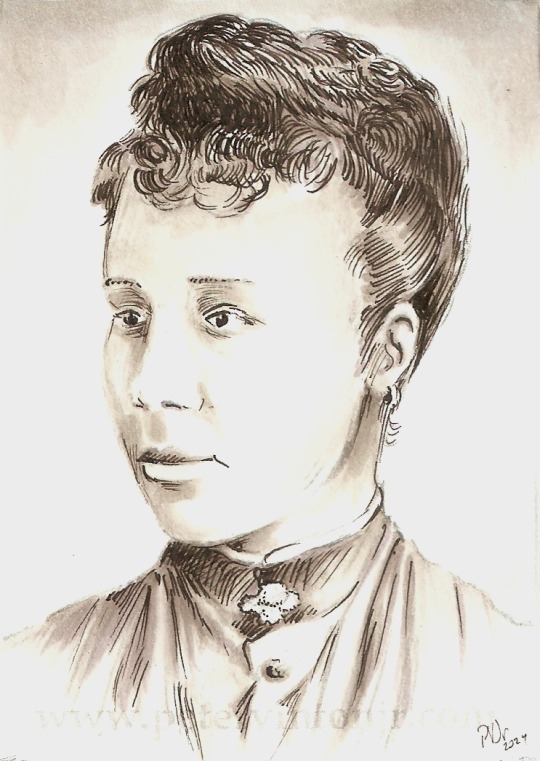
"A nation's greatness is not dependent upon the things it makes and uses. Things without thoughts are mere vulgarities. America can boast her expanse of territory, her gilded domes, her paving stones of silver dollars; but the question of deepest moment in this nation today is its span of the circle of brotherhood, the moral stature of its men and its women, the elevation at which it receives its vision into the firmament of eternal truth."
Born enslaved in 1858 North Carolina to an enslaved mother and her owner, Anna Julia (neé Haywood) Cooper found herself in a post-emancipation world at the age of nine and enrolled St. Augustine's Normal School and Collegiate Institute in Raleigh; originally a teaching school for newly liberated Black citizens. Anna showed an uncanny aptitude for academics, earning money as a tutor and determinedly pursuing subjects normally regarded as off-limits to women.
In 1877 Anna married theology teacher George A.G. Cooper, but sadly the marriage only lasted a few short years --George died in 1879. In 1881 she enrolled at Oberlin College, where she attained her B.A. in mathematics, and eventually her M.A. in education. Afterwards in 1887 she moved to Washington, D.C. and further pursued education, moving in the same orbits as Mary Church Terrell (Lesson #29) and Nannie Helen Burroughs (Lesson #138). In 1892 she was one of the co-founders of the the Colored Women's League of Washington. She eventually became principal of the Washington Colored High School (later the M Street High School, and eventually Dunbar High School), but not without controversy --her unapologetic approach to college preparation was met with disagreement by the all-white Washington, D.C. school board, and she was ultimately forced to resign in 1906. (Boy, it sure is good to know that sort of thing doesn't ever happen anymore...)
She had been pursuing a graduate study at Columbia in 1911, but stepped away from this goal to raise her late brother's five grandchildren. In 1925, at the age of 66, Anna earned her Ph.D in history from the Université de Paris (Sorbonne); the fourth Black woman in the U.S. to receive a doctoral degree. She was also a member of the influential Black women's sorority, Alpha Kappa Alpha. Among her many publications was 1892's A Voice from the South, an early examination on the crucial intersectionality of race and gender, that also called for equal education for women. Anna also founded the the first YWCA chapter for Black women.
Retiring from teaching in 1930, Anna continued to publish and advocate for Black civil rights causes. She ultimately lived to the amazing age of 105, passing away in 1964.
#blm#black lives matter#anna julia cooper#anna julia haywood cooper#nevertheless she persisted#intersectionality#teachtruth#dothework
4 notes
·
View notes
Text
"Il est interdit d'interdire !"
En revisionnant la série, je note de nouveaux petits détails qui m'avaient échappés.
Comme cette phrase prononcée par Chat Noir dans l'épisode Sangsure (saison 4) :
"IL EST INTERDIT D'INTERDIRE".
Cette boutade prononcée à l'origine par l'humoriste Jean Yanne est devenue l'un des slogans les plus marquants des évènements de Mai 68.
Mais qu'est-ce que c'est, Mai 68 ?

Ce mouvement de révolte sans précédent aux allures de révolution a éclaté en France en mai-juin 1968 dans les universités.
Le contexte : la France sort tout juste des Trente Glorieuses, une période de forte croissance économique et d'amélioration du niveau de vie qu’a connue la grande majorité des pays développés entre 1945 et 1975. Malgré tout, tout le monde ne profite pas de cette croissance économique : 2 millions de travailleurs en France sont payés au SMIG ("Salaire minimum interprofessionnel garanti", remplacé par le "salaire minimum interprofessionnel de croissance" (SMIC) en 1970), et le pays compte 500 000 chômeurs. Les travailleurs s'inquiètent pour leurs conditions de travail, et côté étudiant, la massification de l'enseignement supérieur cause d'innombrables problèmes (locaux peu adaptés à cette croissance rapide, manque de matériel, problèmes de transports...).
Au centre de Paris, la révolution gronde. Les étudiants s'inquiètent pour leur avenir. Des débats, des prises de paroles et des assemblées générales ont lieu dans les rues, les entreprises, les administrations et les universités.
Lorsque la police lance une intervention brutale le 3 mai 1968 pour disperser un meeting de protestation tenu par les étudiants dans la cour de la Sorbonne, la riposte est instantanée : de violents affrontements ont lieu dans les rues du Quartier latin, le point culminant étant atteint lors de la nuit désormais symbolique du 10-11 mai 1968 où les combats de rues ont donné lieu à bon nombres d'interpellations et a même fait plusieurs de victimes.
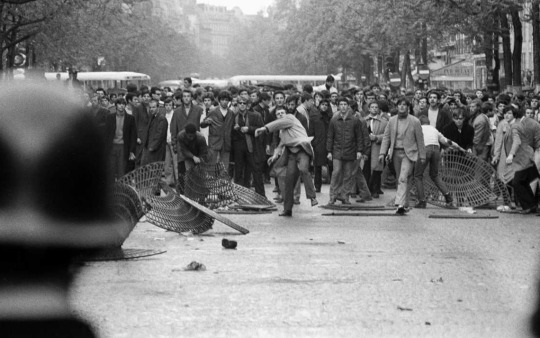
S'en suit la plus importante grève générale sauvage de l'histoire le 13 mai 1968 : la révolution étudiante s'est muée en crise sociale, et une vague de grèves s'enclenche. Le mouvement s'étend, et la France se retrouve totalement paralysée pendant des semaines.
Il y a encore énormément de choses à dire sur cette période qui a révolutionné l'histoire, je ne suis pas forcément la meilleure personne pour aborder le sujet.
Toujours est-il que Mai 68 reste à ce jour le plus important mouvement social de l'histoire de France du XXe siècle : en quelques semaines à peine, la France a fait bouger ses limites au delà de tout ce qui semblait possible. Et malgré l'échec apparent du mouvement de Mai 68, ses retombées sont énormes : cette crise a largement contribué à la modernisation de la société française. Ne serait-ce que pour les jeunes, les femmes, et les ouvriers qui ont réclamé et ont eu plus de pouvoir, plus de parole, plus de liberté. Bon nombre de leurs rêves sont devenus notre quotidien.
#miraculous ladybug#miraculous#adrien agreste#chat noir#ladybug#marinette dupain cheng#mai 68#un peu d'histoire#il est interdit d'interdire#ml analysis#ml thoughts#miraculous floconfettis#history#french history#histoire de france
8 notes
·
View notes
Text

Evening view of Paris.
Photo taken from above the Left Bank (possibly/probably from the Tour Zamansky of the Sorbonne Université). The bridge that is lit up in the center of the photo is the Pont Saint-Louis, which is a pedestrian bridge linking the Île de la Cité with the Île Saint Louis. Behind you can see the Hôtel de Ville and of course, the Basilique du Sacré-Cœur in the upper right corner.
posted to FB group World Beautiful Places & City's
6 notes
·
View notes
Text
« Le jeu de rôle a 50 ans. Et maintenant, que faites-vous ?... »
État de l’art et perspectives pour le cinquantième anniversaire du jeu de rôle
A l’occasion du cinquantième anniversaire de Dungeons & Dragons, l’université Sorbonne Paris Nord et La Rochelle Université organisent, du 21 au 22 juin 2024, un colloque de deux journées d’études dédié au jeu de rôle (et une troisième, le 23 juin, à la pratique). Après cinq décennies de création, le jeu de rôle semble connaître un nouveau souffle aussi bien en termes de publics, que de pratiques, de contenus et d’influences.
10 notes
·
View notes
Text
CHAPADA DOS VEADEIROS- Povos dos Campos Gerais > ANDRÉ DIB

Algumas décadas foram necessárias para que o livro Ansel Adams in Color ( Little, Brown and Company, 1993) do renomado fotógrafo americano tenha sido publicado. O californiano Adams (1902-1984) embora consagrado no fine art do preto e branco em suas imagens da paisagem americana começou a fotografar em cor ainda em 1935 quando da invenção do filme Kodachrome. Já o fotógrafo André Dib, com seu Chapada dos Veadeiros-Povos dos Campos Gerais ( Ed. Origem, 2022), recentemente lançado no Festival Foto em Pauta de Tiradentes foi mais breve ao passar da cor, da qual é um virtuose para o monocromatismo.

Mineiro de Uberaba, radicado na Chapada dos Veadeiros desde 2002, Dib dedica-se a imagem ambiental essencialmente explorando lugares de difícil acesso fotografando paisagens, a fauna e flora cultivando o esplendor da cor destes ambientes como raros fotógrafos do gênero, caso do seu livro Chapada dos Veadeiros (Ed.Origem, 2020) [ leia aqui review em https://blogdojuanesteves.tumblr.com/post/616566807556407296/chapada-dos-veadeiros-andr%C3%A9-dib ], publicação esta que sustenta o livro atual, na qual a inserção humana faz-se mais presente, juntamente com a arrojada opção pelo preto e branco.

Dib confessa que após ver uma exposição do também mineiro Sebastião Salgado, a mesma chancelou a sua ideia- que já era forte em seu pensamento há algum tempo- de optar pelo preto e branco. Afinal, já havia publicado o livro acima em cor, entre outros tantos, frutos do seu vasto trabalho que já lhe rendeu mais de 15 prêmios no Brasil e no exterior. Entretanto, esta "nova" Chapada, é estruturada na impactante presença humana, expressa em belíssimos retratos que ganharam relevância pela sua edição, que traz o tratamento das imagens executado pelo fotógrafo paulista Valdemir Cunha, também editor e publisher do livro, amparadas pelas paisagens, que agora nos remetem ao renomado Adams.

Em texto introdutório, o professor Adilson Fernando Franzin, doutor em Letras pela Université Paris Sorbonne e pela Universidade de São Paulo ( USP) enfatiza a ideia dos retratos: "Gentes do mato e de grota, de vãos e veredas, de capinzais e roças; eis os povos dos campos gerais em permanente simbiose com o Cerrado, o segundo maior bioma da América do Sul." Para ele, "é valido lembrar que os habitantes destas cercanias,- a um só tempo, reais e míticas- formam a incontornável fonte de inspiração e a matéria viva a que lançou mão certo gigante das veredas para compor suas fabulosas histórias que percorreram todos os quadrantes do mundo. " Um chamado João" a quem Carlos Drumond de Andrade, com reverência, indagou num poema sobre o escritor que misticamente "guardava rios no bolso".
Acerta Franzin na analogia a Guimarães Rosa (1908-1967). Os personagens de Dib são nascidos desta literatura assim como a literatura nasce deles. Não há como deixar de lembrar da inglesa Maureen Bisilliat com seu A João Guimarães Rosa ( Gráficos Brunner, 1979). Esta "dramaturgia" já faz algum tempo que é representada por imagens em outros livros. No entanto, poucas tem a relevância destas.

Para muitos artistas, o apelo de fotografar em preto e branco é, simplesmente, uma questão emocional. Não é preciso ser um crítico de arte para perceber que as fotos em preto e branco costumam ser mais dramáticas do que as coloridas. Seus tons escuros e contrastes profundos muitas vezes instilam uma aura quase temperamental ou misteriosa no trabalho. Esse tipo de teatralidade é difícil de reproduzir na fotografia colorida, ainda que esta obtenha algum sucesso. Além disso, os neurobiólogos provaram que algo na fotografia em preto e branco. Sejam as gamas tonais, os pretos ricos ou a luminosidade, atrai-nos psicologicamente.

Por décadas, o filme monocromático imperou na arte. Algo que vinha desde o advento do filme moderno na década de 1880, tempos em que os fotógrafos concentraram-se em dominar o comportamento "básico" da fotografia moderna. Foi somente na década de 1930 que começaram a explorar provisoriamente a fotografia colorida. Nos anos 1960, porém, o mundo da fotografia tornou-se uma explosão de cores com a invenção das câmeras instantâneas. Desde então, escolher a fotografia em preto e branco em vez da colorida tem sido uma escolha muito consciente. Por muitos anos, a fotografia em preto e branco foi o padrão escreveu o fotógrafo espanhol Samuel Cueto.

Certamente, ao olharmos a edição anterior de André Dib sobre a Chapada, vemos que a sua transição para o preto e branco não provocou perdas na exuberância da paisagem, pelo contráriio, esta "ressignificação" está plenamente alinhada com sua produção. O livro, como explica Franzin, " traz simultaneamente um registro sensível e crítico às questões ambientais mais urgentes da região, configurando-se como um brado em prol da natureza que ainda pulsa, instituindo, com engenho e arte, um libelo contra o obscurantismo e a ignorância de nossos dias, sem perder de vista a delicadeza do olhar que sonha não apenas o abraço tel��rico em nacos de nuvens, mas também almeja a força transformadora, o alimento e a cura em mãos humanas." Daí a presença imprescindível dos retratos, que além de belos transmitem a contundência da resiliência do povo da região.

Povos dos Campos Gerais nos mostra igualmente o paradoxo da beleza transmitida entre a terra vibrante e aquela que é destruída, caracterizada aqui pelas imagens de incêndios de áreas imensas do Cerrado, tais como veredas e campos úmidos, ou como escreve o fotógrafo, zonas extremamente sensíveis que são degradadas de forma irreversível secando nascentes e mudando o comportamento do ciclo dos rios e de suas bacias hidrográficas. Segundo dados científicos recentes, estes acontecimentos constituem-se como uma das maiores causas da crise hídrica pela qual passamos nos últimos tempos.

Sendo uma espécie de cartografia do imaginário, como escreve o professor, o potencial narrativo de André Dib impressiona. Mas não somente um potencial natural que o fotógrafo possui, mas sendo uma marca de seu processo criativo e de uma concepção artística. "Não apenas na seara da fotografia documental, a qual prima por contar uma história qualquer, mas sua arte fotográfica, paradoxalmente, parece transcender o tempo e o espaço a tocar o mito num constante flerte com nossas páginas literárias mais genuínas." A publicação tem também um conjunto de detalhadas legendas e audiodrescrição, que ampliam a função da mesma.

Infos básicas:
Edição do livro e imagens: Valdemir Cunha
Editora: Ed. Origem
Direção de Arte: Valdemir Cunha
Projeto gráfico: Editora Origem
Texto: Adilson Fernandes Franzin - Edição bilingue português/inglês
Mapa: Pablo Aguiar Saboya
Editora Executiva: Ligia Fernandes.
Audiodescrição: Marisa Barbosa
Impressão: Pancrom, em Couché fosco, 1000 exemplares.
Projeto contemplado pelo Edital de fomento as artes visuais do Fundo de Arte e cultura do estado de Goiás.
Aquisição do livro editoraorigem.com.br
4 notes
·
View notes
Link
6 notes
·
View notes